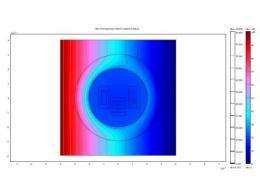New 'thermal' approach to invisibility cloaking hides heat to enhance technology

In a new approach to invisibility cloaking, a team of French researchers has proposed isolating or cloaking objects from sources of heat—essentially "thermal cloaking." This method, which the researchers describe in the Optical Society's open-access journal Optics Express, taps into some of the same principles as optical cloaking and may lead to novel ways to control heat in electronics and, on an even larger scale, might someday prove useful for spacecraft and solar technologies.
Recent advances in invisibility cloaks are based on the physics of transformation optics, which involves metamaterials and bending light so that it propagates around a space rather than through it. Sebastien Guenneau, affiliated with both the University of Aix-Marseille and France's Centre National de la Recherche Scientifique (CRNS), decided to investigate, with CRNS colleagues, whether a similar approach might be possible for thermal diffusion.
"Our key goal with this research was to control the way heat diffuses in a manner similar to those that have already been achieved for waves, such as light waves or sound waves, by using the tools of transformation optics," says Guenneau.
Though this technology uses the same fundamental theories as recent advances in optical cloaking, there is a key difference. Until now, he explains, cloaking research has revolved around manipulating trajectories of waves. These include electromagnetic (light), pressure (sound), elastodynamic (seismic), and hydrodynamic (ocean) waves. The biggest difference in their study of heat, he points out, is that the physical phenomenon involved is diffusion, not wave propagation.
"Heat isn't a wave—it simply diffuses from hot to cold regions," Guenneau says. "The mathematics and physics at play are much different. For instance, a wave can travel long distances with little attenuation, whereas temperature usually diffuses over smaller distances."
To create their thermal invisibility cloak, Guenneau and colleagues applied the mathematics of transformation optics to equations for thermal diffusion and discovered that their idea could work.
In their two-dimensional approach, heat flows from a hot to a cool object with the magnitude of the heat flux through any region in space represented by the distance between isotherms (concentric rings of diffusivity). They then altered the geometry of the isotherms to make them go around rather than through a circular region to the right of the heat source—so that any object placed in this region can be shielded from the flow of heat (see image).
"We can design a cloak so that heat diffuses around an invisibility region, which is then protected from heat. Or we can force heat to concentrate in a small volume, which will then heat up very rapidly," Guenneau says.
The ability to shield an area from heat or to concentrate it are highly desirable traits for a wide range of applications. Shielding nanoelectronic and microelectronic devices from overheating, for example, is one of the biggest challenges facing the electronics and semiconductor industries, and an area in which thermal cloaking could have a huge impact. On a larger scale and far into the future, large computers and spacecraft could also benefit greatly. And in terms of concentrating heat, this is a characteristic that the solar industry should find intriguing.
Guenneau and colleagues are now working to develop prototypes of their thermal cloaks for microelectronics, which they expect to have ready within the next few months.
More information: "Transformation Thermodynamics: Cloaking and Concentrating Heat Flux," Guenneau et al., Optics Express, Vol. 20, Issue 7, pp. 8207-8218.
Journal information: Optics Express
Provided by Optical Society of America
















